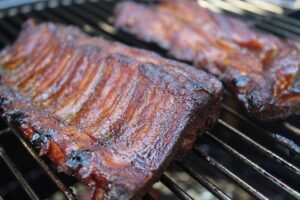If you’re a fan of barbecue, you’ve probably heard of the brisket stall. This phenomenon occurs when the internal temperature of the brisket reaches a certain point and then seems to plateau, sometimes for several hours.
If you’re not prepared for it, the stall can be frustrating and confusing, but understanding what causes it and how to manage it can make all the difference in the final product.
What Causes the Brisket Stall
The brisket stall is caused by several factors, but the main one is collagen breakdown. Brisket is a tough cut of meat that contains a lot of connective tissue.
As the brisket cooks, the heat causes the collagen to break down into gelatin, which makes the meat tender and juicy. However, this process takes time, and when the brisket reaches a certain temperature (usually around 160-170°F), the evaporation of moisture from the surface of the meat causes the internal temperature to plateau.
Other factors that contribute to the stall include the Maillard reaction (which creates the bark on the outside of the brisket), the amount of fat in the meat, and the cooking method (e.g. smoking, braising, etc.).
The stall can last for several hours, and it can be frustrating for cooks who are trying to time their meal.
What Temperature Does Brisket Stall
The temperature at which the brisket stall occurs is usually around 160-170°F. This is the point at which the collagen begins to break down and the evaporation of moisture causes the internal temperature to plateau.
The stall can last for several hours, and it can be unpredictable, so it’s important to be patient and plan accordingly.
Variations in stall temperature and duration can occur based on the cooking method. For example, if you’re smoking the brisket, the stall may occur at a lower temperature than if you’re braising it.
Additionally, the duration of the stall can vary depending on the size of the brisket, the amount of fat, and other factors.
Tips for Managing the Brisket Stall
The most important thing to remember when dealing with the brisket stall is to be patient. Trying to rush the process can result in tough, dry meat. Instead, try these tips for managing the stall:
- Wrap the brisket in foil or butcher paper to help retain moisture and speed up the cooking process.
- Increase the temperature of your smoker or oven to help push through the stall.
- Plan for the stall in your cooking time so that you’re not rushed or stressed when it occurs.
- Consider using a meat thermometer to monitor the internal temperature of the brisket and ensure that it’s cooking evenly.
Conclusion
The brisket stall can be frustrating, but it’s an important part of the cooking process that can’t be rushed. By understanding what causes the stall and how to manage it, you can create a delicious, tender brisket that will be the highlight of your next barbecue.
So the next time you’re cooking a brisket, be patient, plan ahead, and enjoy the process.

